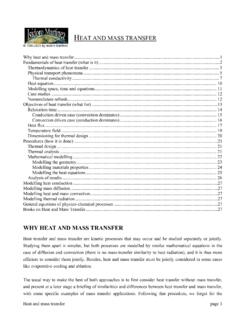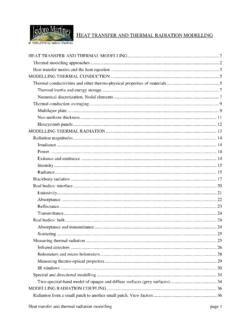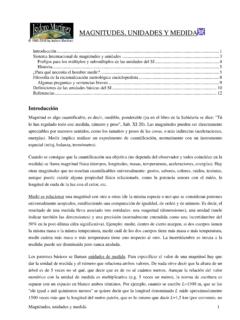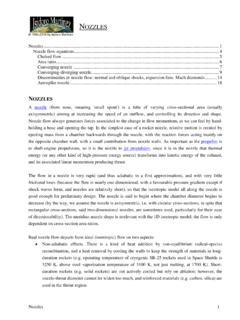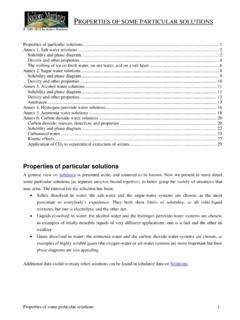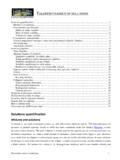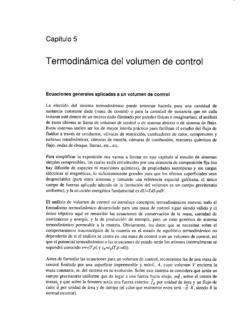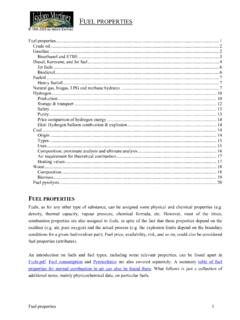Transcription of MASS DIFFUSION - UPM
1 mass DIFFUSION page 1 mass DIFFUSION mass transfer .. 1 What it is and what it isn't .. 1 What it is for. Applications .. 2 How to study it. Similarities and differences between mass transfer and heat transfer .. 2 Forces and fluxes .. 4 Specifying composition. Nomenclature .. 4 Specifying boundary conditions for composition .. 6 Species balance equation .. 9 DIFFUSION rate: Fick's law .. 10 The DIFFUSION equation for mass transfer .. 14 Some analytical solutions to mass DIFFUSION .. 15 Instantaneous point-source.
2 15 Semi-infinite planar DIFFUSION .. 16 DIFFUSION through a wall .. 17 Summary table of analytical solutions to DIFFUSION 19 Evaporation rate .. 22 References .. 23 mass transfer WHAT IT IS AND WHAT IT ISN'T The subject of mass transfer studies the relative motion of some chemical species with respect to others ( separation and mixing processes), driven by concentration gradients (really, an imbalance in chemical potential, as explained in Entropy). Fluid flow without mass transfer is not part of the mass transfer field but of Fluid Mechanics.
3 heat transfer and mass transfer are kinetic processes that may occur and be studied separately or jointly. Studying them apart is simpler, but it is most convenient (to optimise the effort) to realise that both processes are modelled by similar mathematical equations in the case of DIFFUSION and convection (there is no mass - transfer similarity to heat radiation), and it is thus more efficient to consider them jointly. On the other hand, the subject of mass transfer is directly linked to Fluid Mechanics, where the single-component fluid-flow is studied, but the approach usually followed is more similar to that used in heat transfer , where fluid flow is mainly a boundary condition empirically modelled; thus, the teaching of mass transfer traditionally follows and builds upon that of heat transfer (and not upon Fluid Mechanics).
4 In fact, development in mass - transfer theory closely follows that in heat transfer , with the pioneering works of Lewis and Whitman in 1924 (already proposing a mass - transfer coefficient hm similar to the thermal convection coefficient h), and Sherwood's book of 1937 on "Absorption and extraction". Even more, since the milestone book on "Transport phenomena" by Bird et al. (1960), heat transfer , mass transfer , and momentum transfer , are often jointly considered as a new discipline.
5 mass DIFFUSION page 2 As usual, the basic study first focuses on homogeneous non-reacting systems with well-defined boundaries (not only in mass transfer , but in heat transfer and in Fluid Mechanics), touching upon moving-boundary problems and reacting processes only afterwards. As for the other subjects, it is based on the continuum media theory, without accounting for the microscopic motion of the molecules (so that field theory and the fluid-particle concept are applied here too).
6 DIFFUSION theory only applies to molecular mixtures (d<10-8 m); for colloids and suspensions ( m), Brownian theory must be applied, and for larger particles (>10-5 m) Newtonian mechanics applies. Notice that we only consider here mass DIFFUSION due to a concentration gradient, what might be called concentration-phoresis in analogy to other mechanisms of mass DIFFUSION like thermo-phoresis (Soret effect), piezo-phoresis ( DIFFUSION due to a pressure gradient), or electrophoresis ( DIFFUSION due to a gradient of electrical potential applied to ionic media).
7 Traditionally, the field of mass transfer has been studied only within the Chemical Engineering curriculum, except for humid-air applications (evaporation) and thermal desalination processes, which has been always studied in Mechanical Engineering. But mass transfer problems are proliferating in so many circumstances, especially at high temperatures (drying, combustion, materials treatment, pyrolysis, ), that the subject should be covered on different grounds to encourage effective interdisciplinary team-work WHAT IT IS FOR.
8 APPLICATIONS Applications of mass transfer include the dispersion of contaminants, drying and humidifying, segregation and doping in materials, vaporisation and condensation in a mixture, evaporation (boiling of a pure substance is not mass transfer ), combustion and most other chemical processes, cooling towers, sorption at an interface (adsorption) or in a bulk (absorption), and most living-matter processes as respiration (in the lungs and at cell level), nutrition, secretion, sweating, etc.
9 A common process to separate a gas from a gaseous mixture is to selectively dissolve it in an appropriate liquid (this way, carbon dioxide from exhaust gases can be trapped in aqueous lime solutions, and hydrogen sulfide is absorbed from natural-gas sources; when water vapour is removed, the absorption process is called drying. Stripping is the reverse of absorption, the removal of dissolved components in a liquid mixture. Distillation is the most important separation technique.)
10 HOW TO STUDY IT. SIMILARITIES AND DIFFERENCES BETWEEN mass transfer AND heat transfer mass transfer education traditionally follows and builds upon that of heat transfer because, on the one hand, mass DIFFUSION due to a concentration gradient is analogous to thermal-energy DIFFUSION due to a temperature gradient, and thus the mathematical modelling practically coincides, and there are many cases where mass DIFFUSION is coupled to heat transfer (as in evaporative cooling and fractional distillation); on another hand, heat transfer is mathematically simpler and of wider engineering interest than mass transfer , what dictates the precedence.
